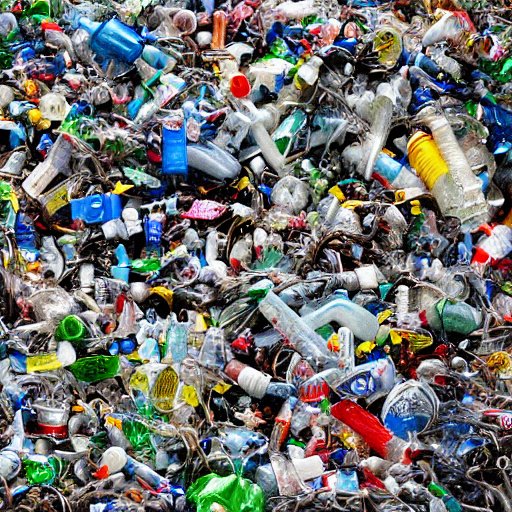Exceeding the planetary limit of plastic
The WWF report on World Environment Day. Here’s why focusing on recycling alone is not enough.
The planetary limit of plastic and chemical pollutants has been exceeded, posing a real risk of irreversible damage to species and human health. How did we get here?

We are surrounded by plastic products, some of which are impossible (or nearly impossible) to recycle, while others – such as furniture, chairs, pens, toothbrushes, toys, combs, sponges, and basins – are not currently allowed to be recycled due to existing regulations. In fact, globally, only 9% of plastic waste is actually recycled, while 19% is incinerated and about 50% ends up in legal landfills. The remaining 22% is either dumped in illegal landfills, burned in the open air, or dispersed in the environment. As a result, up to 20% of plastic waste invades oceans, freshwater bodies, and land every year.
On World Environment Day, the WWF publishes the new report ‘Plastic: From Nature to People. It’s Time to Take Action,’ highlighting that Italy is among the worst polluting countries bordering the Mediterranean, contributing to pollution as the second-largest plastic waste producer in Europe. However, the debate on the effectiveness of recycling in waste management is highly contentious, as evidenced by a recent report by Greenpeace USA, which suggests that recycling plastic increases its toxicity.
The damages caused by plastic
As the report highlights, despite a constantly growing production, plastic disposal remains highly inefficient and ineffective. As a result, up to 22 million tons of plastic waste enter the marine environment and an equal amount enters the terrestrial environment each year, with a significant portion being single-use plastic. Additionally, plastic production currently accounts for approximately 3.7% of global greenhouse gas emissions, and this percentage is projected to increase to 4.5% by 2060 if current trends continue unchecked. However, plastic pollution in nature has already exceeded the “planetary boundary,” beyond which there is no longer the assurance that ecosystems can provide favorable conditions for life. Hence, the need for a global treaty against plastic pollution. The second session of the Plastic Pollution committee recently concluded in Paris, with delegates from 175 countries unanimously agreeing to draft a treaty by the end of 2024. The objective is to decrease the global annual production of plastic, which has reached 460 million tons and could triple by 2060. However, even in this context, there have been pressures from the industry (and countries) reluctant to address the core issue: reducing production.
The circular economy, hierarchy, and the recycling dilemma
To implement a necessary change of course, the solution lies in the circular economy, where the raw materials, such as plastic, from a non-functioning object remain in circulation, in a long and preferably infinite cycle of production, reuse, and recycling, eliminating the stages of raw material extraction and disposal. The Waste Framework Directive establishes regulations and policies for waste management in the European Union and outlines a specific hierarchy that represents priorities in waste management. Prevention and reuse take the top spots, followed by recycling, other forms of recovery (such as energy recovery), and, only as a last resort, disposal. However, the priorities set by the European Union are still a subject of contention, as evidenced by the controversies surrounding the EU regulation to limit packaging. “It is necessary to reduce the production and use of unnecessary and harmful plastics, promote the reuse and repair of plastic products by focusing on innovation,” explains WWF. They also emphasize the importance of extending separate collection to all major consumer sectors, in addition to packaging, to increase the types of objects that can be recycled. This is a highly debated topic, especially since Greenpeace USA recently published a report stating that “recycled plastic becomes more toxic, containing higher levels of chemicals such as benzene, carcinogens, environmental pollutants, and endocrine disruptors that can cause changes in the body’s natural hormone levels.”
What happens to plastic products that cannot be recycled because they are not packaging, as required by current regulations? For example, in Italy alone, we discard 4,000 tons of plastic each year just from toothbrush consumption. “A significant amount of plastic that is not currently being recycled and does not contribute to creating new items,” says WWF. Other examples include a garden chair, which, if recycled, could yield up to 2.8 kilograms of recycled plastic, equivalent to recycling 93 shampoo bottles. Recycling a laundry basin could provide up to one kilogram of recycled plastic, equivalent to recycling 500 water bottle caps. Recycling a cat carrier could yield up to 900 grams of recycled plastic, equivalent to recycling 30 apricot containers. “Without improvement in plastic management and waste disposal, it is estimated that by 2050, the total amount of plastic produced could triple, resulting in increased plastic waste entering the environment,” explains WWF, emphasizing that 12 billion tons of plastic could end up in natural environments. “If this happens,” they add, “in 30 years, there could be more plastic in the sea than fish.”

